- Announcements
- BBQ and Food
- Cars
- Computing
- Cool Stuff
- Current Events
- Electric Vehicles
- Electronics
- Energy
- Flashahaulism
- Funny
- Government
- Hints and Tips
- History
- HVAC
- Induction heating
- Internet
- Lighting
- Misc
- Neon and other lighting
- Nuclear
- Personal
- Pets
- Philosophy
- Photography
- Power Generation
- Product Reviews
- Projects
- Q and A
- RV/Camping
- Science
- Tellico
Categories
Blogroll
 Print This Post
Print This Post
AVS Bus Salvage
PermaLinkAdvanced Vehicle Systems (AVS) was a company set up in Chattanooga, TN by some wealthy folks to glom onto some juicy government money and in the process make the more gullible folks think that they were saving the environment (sic). When the corporate welfare, er, grant money ran out, they closed their doors and went back to playing golf or whatever rich folks do.
Their product was a “parts bin” electric bus. By “parts bin”, I mean that the bus was designed using off-the-shelf industrial and automotive parts. The frame was steel and very heavy, around 12,000 lbs when stripped of all attachments. The air conditioning, for example, was a custom-built residental-style heat pump driven by a very expensive three phase inverter. Nothing except the main drive system was energy-optimized at all. These buses are energy-hogs as vehicles go but they’re electric and so they’re green (sic).
A friend who owns a large scrap metal recycling company bought out what was left of the company when it bankrupted. He had someone else sell off the juicy tidbits like the microturbines and running buses. He gave me the remaining partially assembled buses to salvage. That I’ve been doing for the last couple of weeks. Here are some photos and descriptions.

As they sit in the scrap metal yard
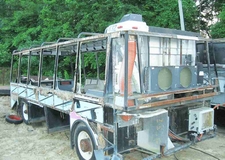
Another view. These are all the ill-fated Capstone micro-turbine equipped hybrid buses. the turbine compartment is the immediate foreground with the exhaust rising through the rear left roof.
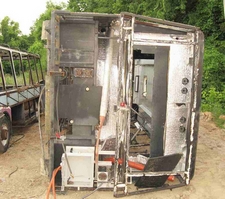
Dead Bus :-) I flipped one chassis up on its side so that I could take a look at and photograph the underside.
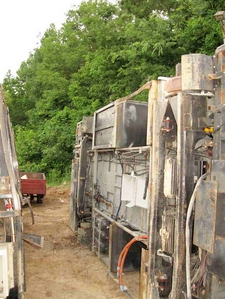
Another view. The orange tubes are the conduit that carried the main battery pack power leads. Using orange flex conduit is a viable alternative to trying to find orange cable.
In this photo I have already removed the DC motor, belt driven air brake compressor from its location just above the grey NEMA 4 box. It used the same open-frame DC motor that the power steering unit (see below) did. Again, hung out in the open exposed to road grime and water.
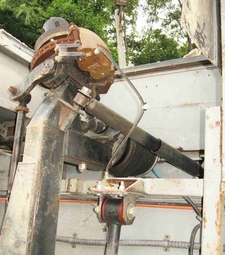
Front axle assembly. That’s the largest hydraulic brake caliper that I’ve ever seen. The brake system is interesting – air over hydraulic up front and air-actuated, cable operated drum brakes in the rear. The suspension is pure air bag which made kneeling for wheelchair access simply a matter of bleeding the front air bags. The axle assembly itself is welded up from structural sheet and tubing. Fairly strong but very heavy.
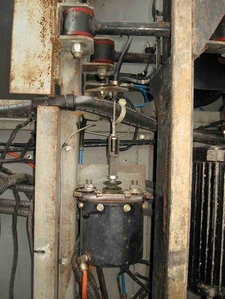
This is the rear brake actuator. An air cylinder pulls on a cable that actually operates the brake. Kinda clumsy compared to conventional air brakes and probably hgih maintenance once those cables get salt in ’em and corrode a bit.
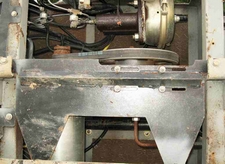
This is the power steering drive. A high voltage DC motor belt-driving a conventional automotive power steering pump. This is an example of the non-optimized, bolt-together and energy-inefficient approach taken in this design. This pump runs all the time, consuming battery pack energy. The V-belt system isn’t particularly efficient, especially when it gets dirty. The motor is an open-frame design. Not particularly good, since this photo was shot looking up at the bottom of the bus. The motor is right out there in the open, exposed to road grime and water.
Now what EVers are most interested in, the Solectria AC drive motors
As you can see, each rear wheel has its own ~70kW AC motor. The short drive shaft drives the input to the planetary reduction drive built into the wheel hub. No, the motor doesn’t directly drive the wheel! There is a shaft encoder in the rear bellhousing of each motor that feeds back speed to the inverter. The silver aluminum bracket attached to the motor in the lower photograph held the variable reluctor pickup for the electronic speedometer. Several magnets are glued to the U-joint hub. The speedometers on these buses read 0.0 miles – never been moved under power.
Again, the suspension is pure air bag with auto-leveling and kneel capability. Though it probably doesn’t matter for the low speed urban service that these buses were designed for, a major deficiency in this design is that all the motor and drive shaft weight is unsprung weight, weight that the shocks and air bags have to manage. If any significant speed was anticipated, this would result in a harsh ride.
This is just a “first look”. I’ll be posting more photographs as I get a chance. I’ll also be offering the motors and certain other components for sale. Priced to move :-)
UPDATE: Seth, formerly of Solectria has told me that these are model AC55 motors.
UPDATE 2: Cut sheet on the motor.
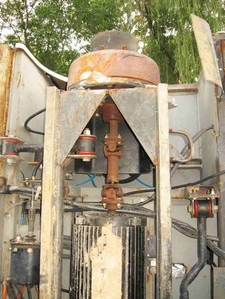
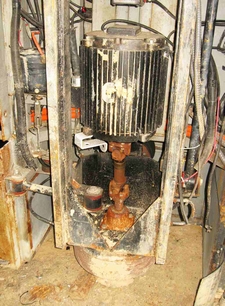
June 10th, 2008 at 3:43 am
Aye, John, you are exposing the dark secrets of the millenium failures of AVS, the short-sighted government programs which expired just before they were about to be proven of value, the abandoned CARB standards, and the hubris & hipocrisy of all involved in public transportation and enviornmental issues during those years.
I was horrified by what I discovered when I bought two of these AVS buses (on eBay, almost three years ago now).
I remember my astonishment when I began breaking one of my buses down, removing seats and stuff– There was a ‘box of air’, providing support for the curb side seat (over the front wheel well cover). When I removed that piece, I discovered that it was 35 pounds of sheet metal, enclosing nothing, protecting nothing, providing an abundance of unneeded (and unwanted!) weight, and illustrating to my sinking heart just how inefficient the design and construction of these buses were. A 2002 model, costing almost 300k, and weighing probably twice as much as it needed to…
The Torque Hubs that came on those AVS buses provide a 12.36 to 1 reduction, but limit top speed to less than 40 MPH (if you remain within the max input RPM range as specified by the manufacturer, Fairfield). AVS advertised a top speed of 45 for these shuttles, but you’d have to exceed the hub’s spec to get the lumbering wallowing giant going that fast. I’ve not driven mine faster than 30 MPH, and would not dare to try.
Like you, I will also be deconstructing my AVS buses, taking a plasma torch to the frames, eventually. I have four of those AVS55 motors and 440 controllers which work well, which I hope to apply to another chassis, someday. The Solectria parts made the purchase worthwhile, along with the 48 Deka Dominator 31G’s that came with each bus (still useful!).
I still hope to drive across this country in an all-electric RV, someday, but I am certain it will *not* be in one of these original AVS shittles (sic).
Good luck with your salvage. I think the AVS frame would make a fine outbuilding– I’m actually thinking of using one of mine for a pool house, if I can get it accepted by our building inspectors here.
Thanks for sharing the info, and let me know if you need anything (I have Parts Manual, Electrical Manual, and Operations Manual for these buses).
May 31st, 2009 at 6:27 am
[…] Neon Glow The Blog of John DeArmond AVS Bus Salvage Posted by root 4 hours ago (http://www.johndearmond.com) Jun 9 2008 leave a comment name required mail will not be published required website copyright 2007 john dearmond powered by wordpress Discuss | Bury | News | Neon Glow The Blog of John DeArmond AVS Bus Salvage […]
May 31st, 2009 at 10:35 am
[…] Neon Glow The Blog of John DeArmond AVS Bus Salvage Posted by root 5 hours ago (http://www.johndearmond.com) Jun 9 2008 leave a comment name required mail will not be published required website copyright 2007 john dearmond powered by wordpress Discuss | Bury | News | Neon Glow The Blog of John DeArmond AVS Bus Salvage […]
February 27th, 2010 at 1:52 pm
i have four AVS buses mfg in 2000, should i but up for sale for scrap them.
April 21st, 2010 at 10:15 am
Those Dryfit traction block batteries are worth a lot of money